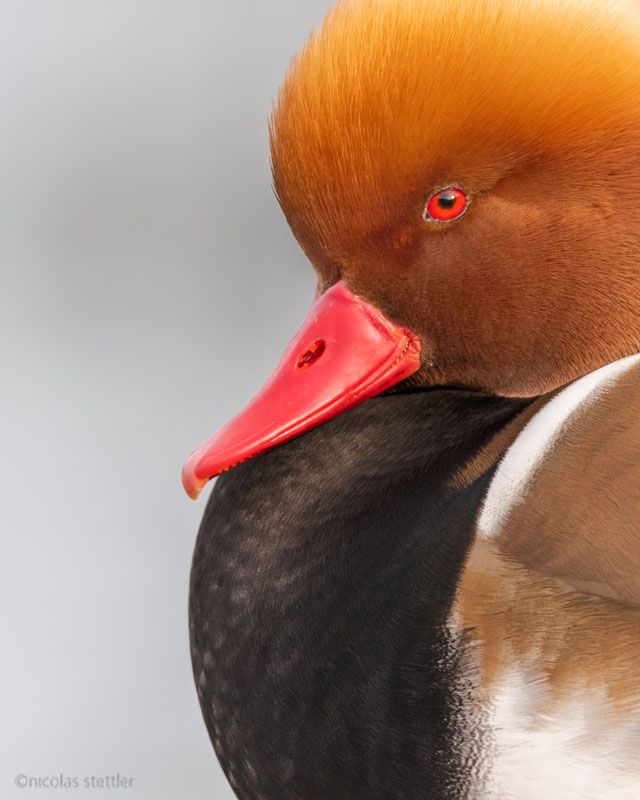Particularly in the winter half year, a large number of ducks can be observed on Swiss water bodies. Various species of ducks spend the winter on our lakes and rivers. But how can you identify the species. I will introduce you to the most common ducks of Switzerland and explain what you should look out for when identifying them.
Mallard
The Mallard is by far the most common duck species in Switzerland during the breeding season. There are an estimated 20,000 - 30,000 breeding pairs every year.
The mallard is a dabbling duck. Dabbling ducks cannot dive and search for food by dabbling (with their head under water) or straining by filtering small plant particles or plankton from the water. Apart from their plant-based nutrition, the mallard also rarely eats small animals such as snails, insects or worms, as well as bread in parks or harbours
The Mallard has only low demands on its habitat and can also be found in water bodies in the middle of the settlement areas. The nest location is also chosen without many requirements and the nest can even be found in flower pots or in house corners.
In winter the lakes in Northern Europe are freezing over. Many duck species, including mallards, therefore have to move to the southwest. In Switzerland - as in the whole of Central and Western Europe - the larger water bodies do not freeze over. Many water birds therefore come to us in winter.
Mallard male

The male Mallard can be easily recognized in its breeding plumage by its shimmering green head. But watch out! Depending on the light, the head can also shimmer bluish or violet metallically. Further distinguishing features are the yellow beak, the white neck ring, the brown breast and the grey patterned body.
In summer the males molt into an eclipse plumage. They lose their striking colouring and change to a more inconspicuous plumage. This is very similar to the plumage of the female. The male can be easily recognized by his beak at this time. The beak is yellow all year round, while the female has an orange-black beak.
Mallard female

The female Mallard is not as strikingly coloured as the male. It has a brown pattern all over its body. This pattern can also be observed in many females of other dabbling ducks.
To distinguish the females of the dabbling ducks, there are two characteristics. One is the colour of the mirror, an area on the wing. It is composed from several feathers and is usually strikingly coloured. Both females and males show the mirror. In the case of the Mallard Duck it is blue with a white border. However, the mirror can be covered by other feathers depending on the duck's posture.

Fortunately, there is a second feature that can be used to distinguish female ducks. This feature is the beak.
The beak of the female Mallard Duck is mostly orange, but it also has a certain amount of black. The amount of black varies greatly from specimen to specimen. Basically, you can remember the following:
If the black and orange part of the beak merge irregularly, it is a female Mallard Duck. What I mean by that is that the colours are not separated by an edge, but there are patterns and gradients.
Gadwall
The Gadwall is found in Switzerland mainly in winter. Up to 10,000 individuals migrate to Swiss lakes to spend the winter. As a breeding bird, the Gadwall is very rare. The breeding population is estimated at around 5-10 breeding pairs per year. Of these, around 5 breeding pairs fall into a single area in Aargau.
The Gadwall also belongs to the dabbling ducks. It feeds almost exclusively on plants.
Gadwall male

The Gadwall male is quite inconspicuously coloured and patterned in grey throughout. The rump (rear end) and the beak are black. On the back the male has long shoulder feathers. These feathers are also called decorative feathers.
Gadwall female

The female is similarly coloured like the Mallard Duck-female. However, unlike the Mallard, the Gadwall has a completely white mirror.
The beak is orange and black like the Mallard-female. However, both colours are clearly separated on the beak of the female Gadwall. Along the beak you can see a sharp edge between the two colours.
Pintail
The Pintail is only a winter visitor in Switzerland. It spends the summer further in the northeast. In winter, there around 1,000 pintails on our lakes. As with all waterfowl, this number can fluctuate considerably from year to year, as the numbers are highly dependent on the weather.
The winter population of the Pintail has increased slightly in Switzerland in recent years.
Pintail male

In my opinion the Pintail is one of the most beautiful duck species in Europe. The duck got its name because of its elongated tail feathers. The long tail feathers can be seen on both the male and the female. On the male, however, the spit is much more pronounced.
The male has a white breast. This forms into a strip, which reaches up to the back of the head. The head is uniformly brown and shimmers slightly pink under the right light conditions. The body has a fine grey pattern and, on the back, it has extended shoulder feathers. The shoulder feathers of the Pintail are much longer than those of the Gadwall.
Pintail female

The female of the Pintail duck is generally somewhat lighter coloured than the other female dabbling ducks. The flight feathers are very long and stand out. Other distinguishing features are the grey beak and, as mentioned before, the long tail feathers.
Shoveler
The Shoveler can be observed in Switzerland almost only in winter. The winter population of the Shoveler duck is around 1,000 individuals. However, in contrast to the Pintail, the shoveler breeds irregularly in Switzerland.
The Shoveler Duck has specialised in filtering out plankton. Its large beak resembles the shape of a spoon and helps it to filter large quantities of water efficiently. The bristle-like rows of lamellae on its beak trap tiny creatures and plant particles, which they then eat.
Shoveler male

The male has a white body and orange-brown flanks. The dark head can have a strong greenish shimmer depending on the light.
Unlike the other dabbling duck, the Shoveler Duck male has a very bright, slightly yellow eye. Coloured eyes are usually seen on the males of diving ducks.
Löffelenten-Weibchen

The female of the Shoveler Duck is coloured quite inconspicuously, typical for dabbling ducks. Apart from the green mirror, the Shoveler Duck female can be identified most easily by its large beak.
Like the female Pintail, the female Shoveler Duck also has very long feathers which extend beyond the body.
Common Teal
The Common Teal is the smallest duck in Europe. This is particularly noticeable in direct comparison with other species.
The Teal also belongs to the dabbling duck family and feeds mainly on water plants.
In Switzerland, the Common Teal can also be observed almost exclusively in winter. Breeding records in Switzerland are irregular and rather rare. In winter, around 4,000 to 5,000 Teals migrate to Swiss waters.
Common Teal male

Males can easily be identified by their head pattern. This is mostly reddish brown and it shows a green half-moon shape on the sides. The two colours are separated by light lines.
Further features are the horizontal white and black stripe over the flanks, the extended shoulder feathers and the beige rump.
Common Teal female

In addition to the significantly smaller size, the female Teal can also be determined by the colour of the mirror. The mirror of the Teal is green. Compared to the rest of the body, the rump is very bright and, depending on the individual, almost white.
Another feature is the dark grey beak, which only takes on a slightly orange colour at the base of the beak and the edges.
Garganey
The Garganey is the only dabbling duck which is a long-migrating bird. This means that in autumn this species flies south, across the Sahara to the tropical rain forest. There the duck spends the winter before returning to Europe in spring.
In Switzerland, this species breeds only irregularly. However, during migration periods, it can be observed in various waters in Switzerland.
Garganey male
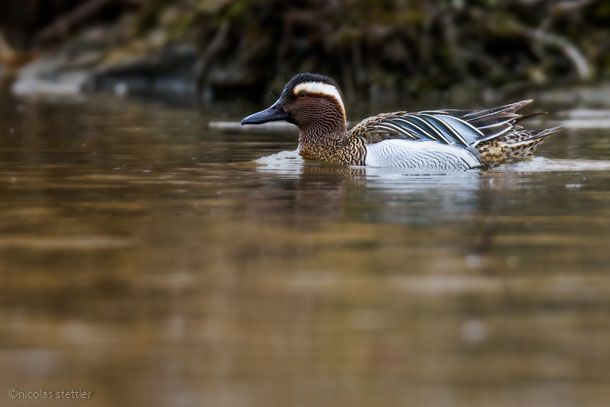
The male is somewhat similar to that of the Pintail. Both have a brown head with a little white at the back of their head. The Garganey, however, has a white stripe over the eye, whist the Pintail has a white stripe from the chest up to the back of the head.
The two can also be distinguished by the colour of the breast: the Garganey has a brown patterned breast. The Pintail on the other hand, has a white, plain breast.
Garganey female
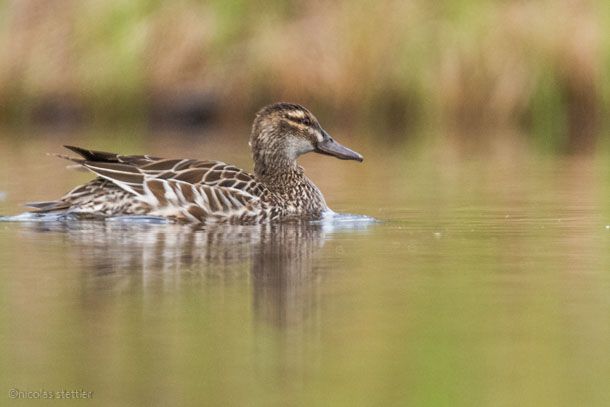
The strong contrasty plumage distinguishes the female Garganey a little from the other dabbling ducks. Otherwise it can only be identified by the head pattern. This consists mainly of a dark overeye strip and a light throat.
Eurasian Wigeon
The Eurasian Wigeon breeds exclusively in the north of Europe. In Switzerland, the duck can only be observed in winter. In winter, the population is around 3,000 to 4,000 individuals.
The wigeon has a very significant call which resembles the whistle of a Marmot. Because of that, in German it’s called ‘Whistle Duck’.
The Eurasian Wigeon also belongs to the group of dabbling duck. Instead of just looking for food itself, the Wigeon has developed another strategy. It tries to steal food from diving water birds, such as the Coot. This behaviour can also be observed in other dabbling duck, but the Wigeon does it most often.
Eurasian Wigeon male
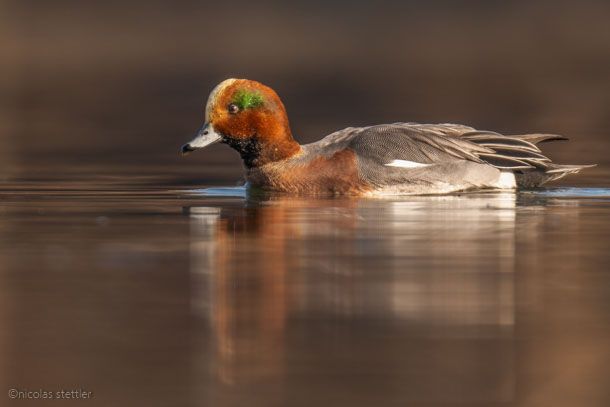
The male Wigeon is characterized by an orange-brown head, a slightly pink breast and a black rump with a white spot in front of it. Like the Teal, the Wigeon also has a horizontal white stripe over its flanks.
Eurasian Wigeon female
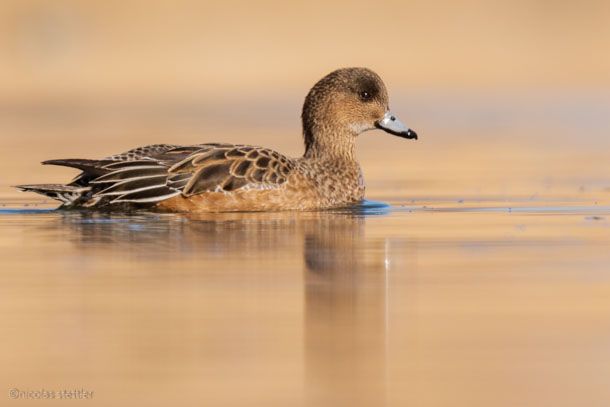
The female Wigeon is, compared to the other dabbling ducks, relatively unpatterned. Especially the flanks are practically plain.
The mantle and the shoulder feathers are very strongly patterned and also quite dark, while the remaining plumage is rather rusty brown.
Red-crested Pochard

The Red-crested Pochard doesn't belong to the dabbling ducks but to the diving ducks. As the name suggests, diving ducks can search for food not only by dabbling and straining but also by diving. Unlike most diving ducks, the Red-crested Pochard feeds mainly on plants. The stonewort makes up a large part of their nutrition.
The distribution area of the Red-crested Pochard lies in Central, Southwest and Southeast Europe. The duck also breeds regularly in Switzerland. In recent years, the number of broods in Switzerland have increased considerably. The population is now around 300 breeding pairs.
In winter, instead of migrating south, many Red-crested Pochards even fly further north. In addition to the breeding birds that stay in Switzerland in winter, there are ducks from the south that join the breeding population.
Why the Red-crested Pochard pursues such a migration strategy is largely unknown. The good food supply could be one of the reasons why so many Red-crested Pochards spend the winter in Switzerland. The winter population is at almost 40,000 individuals. By comparison, 40 years ago, around 200 birds were counted in Swiss water bodies in winter.
Red-crested Pochard male

The male of the Red-crested Pochard is particularly striking because of its orange head and red beak. Besides the beak, the eye is red too.
Both the breast and the rump are black and are separated by white flanks.
In summer, the male can be observed in their eclipse plumage. This plumage is very similar to that of the female and only the red beak and the red eye distinguish males and females at this time of the year.
Red-crested Pochard female

The female of the Red-crested Pochard is light brown to beige and plain. The upper part of the head is slightly darker than the throat and the ear.
It has a dark eye and the beak is mostly grey to dark grey.
Pochard

The Pochard is also a diving duck. It feeds on animal food which is typical for diving ducks. The food consists mainly of mussels, snails, larvae and other small animals.
In Switzerland, the Pochard is mainly a winter visitor, but only a rare breeding bird. The breeding population is estimated at around 6-9 breeding pairs.
The winter population is estimated to be at around 70,000 Pochards.
The high number of winter visitors is due to the introduction of the Zebra Mussel. This was introduced into Switzerland at around 1960 and has since then spread rapidly and displaced native mussel species.
As a result, the food supply, especially for Pochard and Tufted Duck, has greatly improved and the winter population has shot up.
Pochard male

The male Pochard is characterized by its wine-red head and grey patterned body. The breast is coloured black.
Similar to the Red-crested Pochard, the male Pochard has red eyes. The female has a dark brown eye.
Pochard female
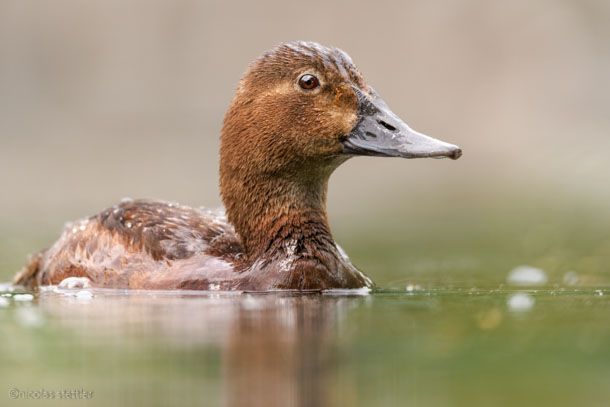
The female is mostly brown to grey coloured. Head and chest are unpatterned brown, while the rest of the body is slightly brighter and slightly patterned.
Many individuals have a pale eye-stripe and a lighter plumage at the base of the beak.
Tufted Duck

The Tufted Duck is also a diving duck and, like the Pochard, feeds mainly on animal food. The population of the Tufted Duck has also increased considerably after the introduction of the Zebra Mussel.
In the last 10 years, however, the winter population has halved again. Out of 200,000 individuals, 'only' 100,000 Tufted Ducks now spend the winter in Switzerland.
This means that the Tufted Duck is still the most common water bird in Switzerland in winter. But only just ahead of the coot, which will soon overtake the Tufted Duck. The most common duck will remain the Tufted Duck, as the coot does not belong to the ducks, but to the Rails.
The reason for the strong decrease in the winter population of the Tufted Duck is probably climate change. The birds have to move less to the southwest to find water bodies that are not frozen. As a result, the wintering grounds of many water birds have shifted further and further to the northeast in recent years.
As a breeding bird, however, the Tufted Duck is increasing slightly. The population is estimated at around 160-280 breeding pairs. In Switzerland, the Tufted Duck breeds mainly in the Alps.
Tufted Duck male
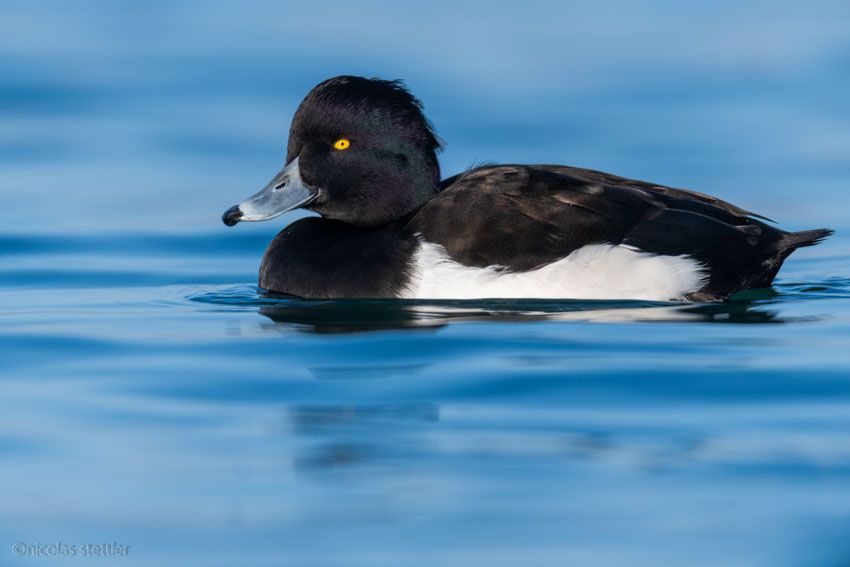
The Tufted Duck got its name because of the long tuft at the back of the head. This is particularly pronounced in the male.
The Tufted Duck male is, with the exception of the white flanks, coloured black. The feathers on the head can shimmer metallically depending on the light.
The yellow eye can be seen on both males and females.
Tufted Duck female
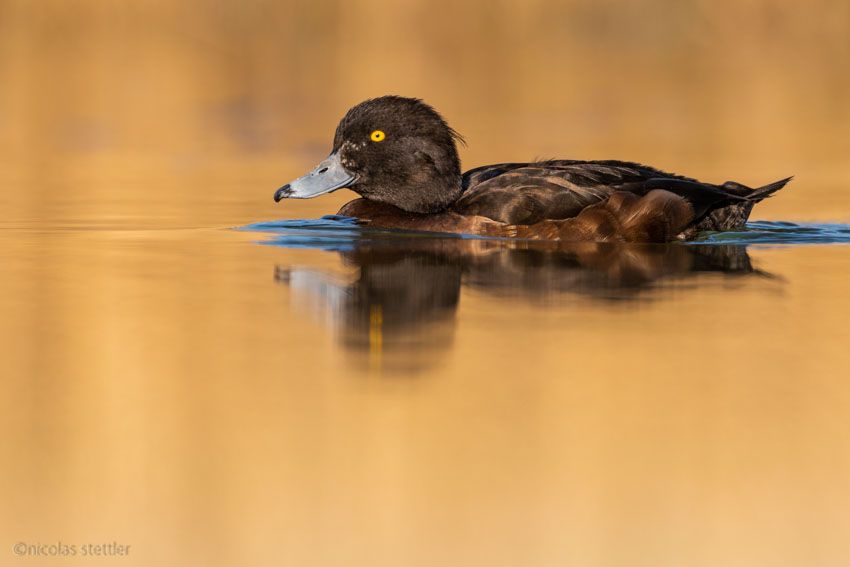
The female of the Tufted Duck is dark brown to black and only the flanks appear in a slightly brighter tone.
The tuft of feathers can be very pronounced or completely missing. This all depends from individual to individual. Some individuals also have white feathers at the base of the beak.
Common Merganser
The Common Merganser belongs to the sea ducks and mergansers. Like the diving ducks, the sea ducks and mergansers can also dive.
It feeds mainly on fish but especially in winter it can also be found near humans, where it occasionally eats bread from people.
The Common Merganser is quite common especially in winter. The winter population is between 5'000 and 6'000 individuals.
In Switzerland, however, it is not only a winter visitor but also a regular breeding bird. The breeding population of the Merganser is estimated at about 600-800 breeding pairs. The breeding birds in Switzerland all belong to the relatively small breeding population of the Alpine arc. This population is genetically different from the breeding population in northern Europe.
Common Merganser male
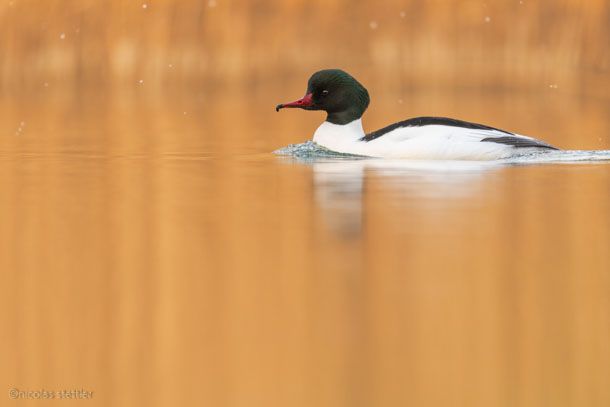
Common Mergansers can easily be identified by their long, slender beak. To prevent fish to tear themselves away, Mergansers have have small teeth.
The male has a black head, which can also shimmer green in the light. Chest and flanks are white. The back is black and grey.
Common Merganser female
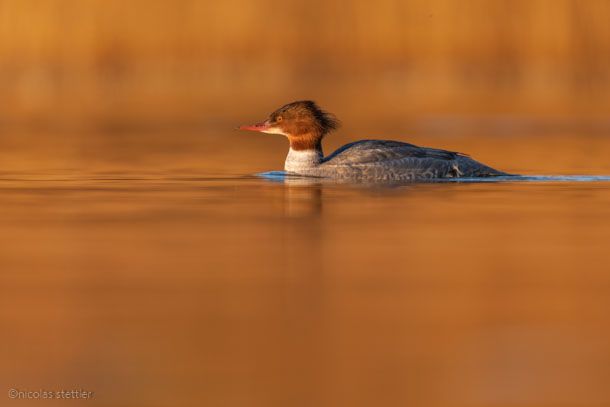
The female is generally grey in colour and has practically no pattern. The head is brown and the feathers on the back of the head stick out. The throat is slightly lighter than the rest of the head and sometimes almost white. Between head and body there is a sharp borderline.
*The breeding and winter population are according to the data of Vogelwarte Sempach
You might also find interesting:
Bird Photography - Create impressive images
Photographing birds can be very difficult. In this article you will learn how to create impressive and unique pictures of birds. I explain what you should pay attention to when taking pictures and where you can find birds that you can easily photograph. Learn from my tips and tricks, which I myself have learned in the last years while photographing.
Langeoog – Birdphotography in winter
In this blog article I write about my stay on Langeoog, an island in the Wadden Sea. There I was looking for waders, water birds and other birds that spend the winter on and around the island. But for once the weather was not on my side and making the photographing for me and my equipment an ordeal.













